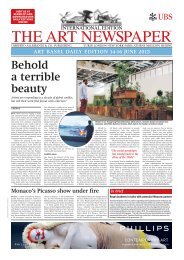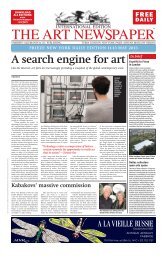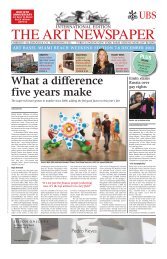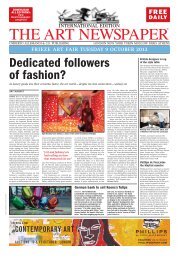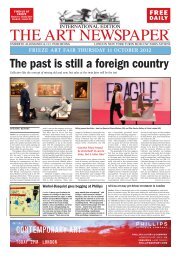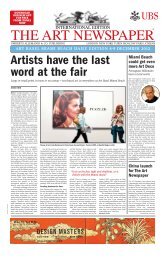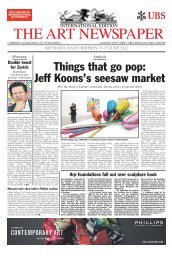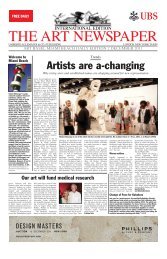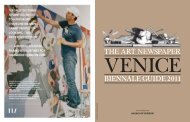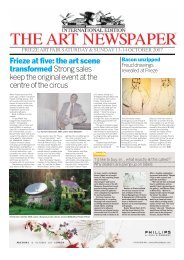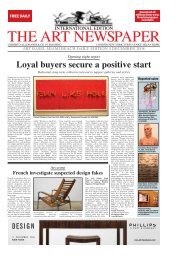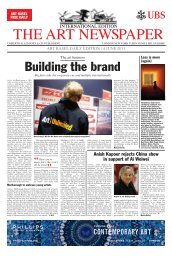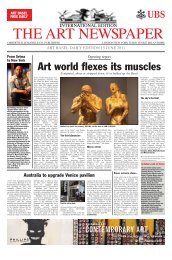Issue 2 - The Art Newspaper
Issue 2 - The Art Newspaper
Issue 2 - The Art Newspaper
Create successful ePaper yourself
Turn your PDF publications into a flip-book with our unique Google optimized e-Paper software.
8<br />
FEATURE<br />
Two leading collectors of<br />
contemporary art in<br />
London have revealed<br />
their desire for their art<br />
to remain on public display<br />
in perpetuity.<br />
David Roberts, the Scottish property<br />
developer who last month inaugurated<br />
a new home for his collection<br />
in Camden Town, and Anita<br />
Zabludowicz, the wife of a Finnish<br />
financier and property investor who<br />
has shown her collection in a former<br />
Methodist chapel in Chalk Farm since<br />
2007, both say they hope their collections<br />
will continue to exist as discrete<br />
entities long into the future.<br />
“I do want the collection itself and<br />
the foundation [that runs it] to continue.<br />
I don’t want a situation where I<br />
die and the whole thing gets sold off<br />
and disappears,” Roberts says.<br />
Zabludowicz says she has set up a<br />
“structure” which involves her children<br />
and includes trustees to shepherd<br />
the collection she has assembled<br />
with her husband, Poju, into the<br />
future. “Our intentions are [for it] to<br />
continue in the same direction, while<br />
at the same time, also [give to] institutions<br />
such as the Tate. It would not be<br />
our wish for our collection to be sold<br />
entirely or given entirely unless<br />
absolutely necessary.”<br />
<strong>The</strong> collectors, both of whom own<br />
around 2,000 works of international<br />
contemporary art and who organise<br />
regular, curated shows in the art<br />
spaces they run, are two of a growing<br />
number of art buyers around the<br />
world who are opening private<br />
spaces to show their purchases. It<br />
remains to be seen whether many of<br />
these galleries or the collections that<br />
fill them will survive past the lifetime<br />
of their founders.<br />
One art world insider who asked<br />
not to be named is sceptical. “Forever<br />
is a very long time,” he says. <strong>The</strong> longterm<br />
costs of displaying art, with all<br />
its ancillary expenses such as conservation,<br />
storage and insurance, are<br />
likely to deter all but the most committed<br />
from attempting to create a<br />
permanent display intended to survive<br />
after they are gone, he adds.<br />
<strong>The</strong>se costs make it difficult to<br />
even give art away for free. More<br />
than two years ago Charles Saatchi<br />
offered around 200 works, including<br />
pieces by Tracey Emin, Grayson Perry<br />
and the Chapman Brothers, as a gift<br />
to the nation with enough funds to<br />
THE ART NEWSPAPER FRIEZE ART FAIR Wednesday 10 October 2012<br />
Forever is a very<br />
long time<br />
Building a great collection is one thing, but securing its long-term future is<br />
another matter. Leading collectors ponder the price of posterity. By Cristina Ruiz<br />
provide for the future cost of maintaining<br />
the art. But discussions with<br />
the government appear to have<br />
reached a stalemate.<br />
Crucially, Saatchi has no building<br />
of his own that could display his collection<br />
in the long term. Unlike<br />
Roberts and Zabludowicz, who both<br />
own the buildings they use to display<br />
their art, he has instead leased a succession<br />
of spaces for the various<br />
incarnations of his gallery, which is<br />
currently based in Chelsea.<br />
Despite the government’s failure<br />
to reach an agreement with Saatchi,<br />
sources say the collector remains<br />
committed to putting a large part of<br />
his collection into a foundation<br />
whose trustees will manage it, protect<br />
its future and ensure it is publicly<br />
displayed.<br />
Collectors seeking governmentfunded<br />
homes for their art have<br />
rarely been successful. In 1992, the<br />
Iranian-born Nasser David Khalili<br />
offered his Islamic collection, considered<br />
one of the world’s finest, to the<br />
British government on a 15-year loan<br />
on the understanding that the loan<br />
“Private collectors can move quickly, they have more<br />
money… it would be irresponsible for national<br />
museums to commit [to young artists] so early”<br />
would become a gift if a suitable<br />
building were provided.<br />
<strong>The</strong>se conditions were not<br />
accepted and Khalili withdrew his<br />
offer. Twelve years later he announced<br />
his intention to cover all the costs of<br />
setting up a museum in London himself<br />
“within five years” and to provide<br />
a multi-million pound endowment to<br />
cover the running costs. <strong>The</strong> museum<br />
never materialised.<br />
Museum partnerships<br />
Public collections have been built<br />
with the art bought by private individuals<br />
and today’s contemporary art<br />
collectors have a distinct advantage<br />
over museums such as the Tate when<br />
it comes to securing important works<br />
of our time. Private galleries complement<br />
public institutions, says Andrew<br />
Renton, the director of Marlborough<br />
Contemporary, who previously<br />
worked with the London collectors<br />
Freddy and Muriel Salem for 12 years,<br />
helping them to assemble the<br />
Cranford Collection.<br />
“Private collectors can move more<br />
quickly. <strong>The</strong>y have more money for<br />
acquisitions and they’re more ambitious<br />
in their purchases, often buying<br />
artists who are young and assembling<br />
large groups of their work. By<br />
definition it would be irresponsible<br />
for a national museum like the Tate<br />
to commit [to artists] so early; in a<br />
way these public and private spaces<br />
need each other,” Renton says.<br />
But today everyone is a collector<br />
and there is the<br />
thorny issue, rarely<br />
discussed in public, of<br />
whether museums<br />
actually want the art<br />
assembled by the<br />
plethora of contemporary<br />
art collectors<br />
active in today’s market.<br />
Speaking at a<br />
panel on private galleries<br />
at the <strong>Art</strong> Basel<br />
fair last year, the director<br />
of Tate Modern,<br />
Chris Dercon, noted<br />
that many buyers purchase<br />
and display<br />
works by the same trendy artists in<br />
spaces that all resemble one another.<br />
Private galleries are now everywhere,<br />
said Dercon. “<strong>The</strong>y have the<br />
same architects, the same white<br />
walls, the same works of art,” he<br />
said, adding that collectors need to<br />
be more discerning when buying art.<br />
He also noted that the programming<br />
in private galleries lacks the depth of<br />
museum displays. Public institutions<br />
can give art a context, he said, which<br />
is impossible for private collectors.<br />
“At the Tate we can show something<br />
contemporary from Brazil alongside<br />
a Mondrian. A private collection<br />
can’t do that because they don’t have<br />
a Mondrian.”<br />
Museums are also wary of collectors<br />
wishing to impose conditions on<br />
gifts or remaining involved in the<br />
management of their art once it has<br />
been transferred to a public collection.<br />
<strong>The</strong> part gift/part acquisition<br />
deal brokered by the dealer Anthony<br />
d’Offay with the Tate and the<br />
National Galleries of Scotland in 2008<br />
for a large collection of contemporary<br />
art divided into “artist rooms” which<br />
tour regional museums around the<br />
country is a rare exception.<br />
<strong>The</strong> ambivalence works both ways.<br />
Collectors who have tasted the thrill of<br />
running their own curatorial programme<br />
don’t want to see their art<br />
subsumed into a larger museum collection.<br />
“<strong>The</strong>re’s a possibility we’ll<br />
donate work to museums,” Roberts<br />
says, “but I don’t think I’d want to say:<br />
‘Here’s the collection’, and give it to<br />
the Museum of Modern <strong>Art</strong> or the<br />
Tate. I wouldn’t want it to disappear in<br />
the vaults of some vast museum.”<br />
Instead, says Roberts, “I like the<br />
idea of doing things with regional<br />
museums which often don’t have the<br />
resources to buy contemporary art…<br />
there are a lot of great spaces outside<br />
London,” he says,<br />
noting that he has<br />
loaned works for an<br />
exhibition opening<br />
later this month at<br />
the Hepworth<br />
Wakefield in Yorkshire<br />
which has “a very good collection<br />
of works by Hepworth<br />
and Henry Moore but very few contemporary<br />
pieces”.<br />
Frank Cohen, the DIY magnate<br />
who has shown his collection of international<br />
contemporary art in an<br />
industrial estate outside<br />
Wolverhampton for nearly six years,<br />
once had plans to open a gallery in<br />
Manchester called the Frank Cohen<br />
Museum of Contemporary <strong>Art</strong>.<br />
Speaking to a journalist from the<br />
Independent in 2004, Cohen said: “I<br />
want to put right the situation that,<br />
outside London and people like<br />
Saatchi with his gallery, there are no<br />
privately run art galleries and collections.”<br />
<strong>The</strong> museum never opened<br />
due to disagreements with the developers<br />
who owned the building. “It<br />
would have been a great thing,”<br />
Cohen says. “It’s Manchester’s loss.”<br />
Now the collector says he “ha[s]n’t<br />
got a clue” what will happen to his<br />
collection in the long term although<br />
he hopes it will remain “intact” and<br />
that his children will “take it over and<br />
continue where I left off.” Meanwhile,<br />
Cohen is opening a London display<br />
space in a former milk depot in<br />
Bloomsbury with the art adviser<br />
Nicolai Frahm to host loan exhibitions<br />
and show art from both their holdings.<br />
<strong>The</strong> gallery should open within<br />
the next two months.<br />
Zabludowicz shares the desire for<br />
her collection, which focuses particularly<br />
on emerging artists, to be seen<br />
in multiple venues and she has<br />
recently started staging shows in the<br />
THE INTERNATIONAL EXPOSITION OF CONTEMPORARY & MODERN ART<br />
APPLICATIONS NOW ONLINE AT EXPOCHICAGO.COM<br />
Private collectors put on a<br />
show: “<strong>The</strong> Summer Sessions”<br />
at the Zabludowicz Collection<br />
(above), “A House of Leaves”<br />
at the David Roberts <strong>Art</strong><br />
Foundation (left) and<br />
Saatchi’s leased<br />
space in Chelsea<br />
New York offices of<br />
her husband’s private<br />
investment<br />
group, Tamares. She<br />
has also launched an<br />
artist residency programme<br />
at Sarvisalo in<br />
Finland where she and her husband<br />
have a home. When asked to<br />
consider where she wanted her collection<br />
to be in 20 years’ time, she<br />
said: “I hope that it will be on display<br />
in many places and my current ambition<br />
is to loan even more works from<br />
the collection to public institutions so<br />
that as many people as possible get to<br />
see art that is being made right now.”<br />
Ultimately, the proliferation of private<br />
galleries has made more art<br />
accessible to more people, usually for<br />
free. Many of these spaces run education<br />
and outreach programmes and<br />
welcome students. Roberts, for example,<br />
is planning a research library in<br />
the Camden Town headquarters of<br />
his collection. However, only time<br />
will tell which galleries and collections<br />
are here to stay.<br />
• “A House of Leaves: First Movement”,<br />
which includes work by Louise Bourgeois,<br />
Thomas Houseago, Martin Kippenberger and<br />
Rebecca Warren, is on display at the David<br />
Roberts <strong>Art</strong> Foundation (until 10 November),<br />
Symes Mews, NW1 7JE. <strong>The</strong> foundation will<br />
stage performances of works by Nina Beier,<br />
Chosil Kil, Alvin Lucier, Eddie Peake and<br />
Steve Reich on 11 October at 7pm<br />
• “To Hope, to Tremble, to Live: Modern<br />
and Contemporary Works from the David<br />
Roberts Collection” is at the Hepworth<br />
Wakefield in Yorkshire from 27 October to<br />
3 February 2013<br />
• “Matthew Darbyshire: T Rooms” (until<br />
2 December) and “Zabludowicz Collection<br />
Invites: Richard Sides” (until 21 October) are<br />
on show at the Zabludowicz Collection, 176<br />
Prince of Wales Road, NW5 3PT<br />
NAVY PIER<br />
19—22<br />
SEPTEMBER<br />
2013<br />
ZABLUDOWICZ: PHOTO BY STEPHEN WHITE, DAVID ROBERTS ART FOUNDATION: © 2012 MARK BLOWER, SAATCHI GALLERY: © 2009 MATTHEW BOOTH, ALL RIGHTS RESERVED



